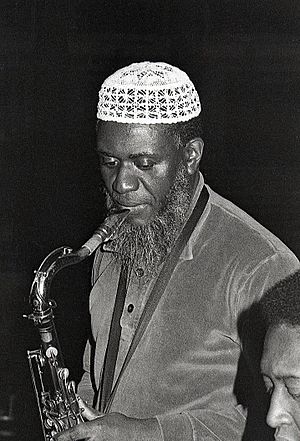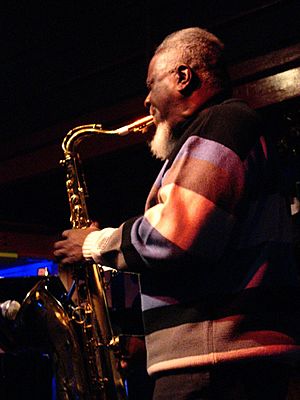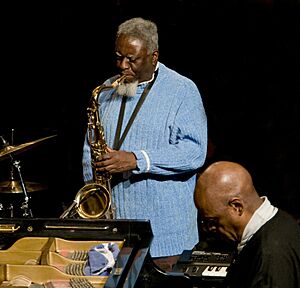Pharoah Sanders facts for kids
Quick facts for kids
Pharoah Sanders
|
|
|---|---|

Sanders in 2006
|
|
| Background information | |
| Birth name | Farrell Sanders |
| Born | October 13, 1940 Little Rock, Arkansas, U.S. |
| Died | September 24, 2022 (aged 81) Los Angeles, California, U.S. |
| Genres | Jazz, free jazz, avant-garde jazz, world fusion, ethno-jazz |
| Occupation(s) | Musician, composer, bandleader |
| Instruments | |
| Years active | 1964–2022 |
| Labels | Douglas, Theresa, Impulse!, Strata East, Luaka Bop |
Pharoah Sanders (born Farrell Sanders; October 13, 1940 – September 24, 2022) was an American jazz saxophonist. He was known for his unique and powerful saxophone sound. He used special techniques like "overblowing" to create many different sounds.
Sanders played a big part in developing free jazz and spiritual jazz. Free jazz is a style where musicians have a lot of freedom to improvise. Spiritual jazz often has a calm, thoughtful, and sometimes religious feeling.
He became famous while playing with jazz legend John Coltrane in the mid-1960s. Later, Sanders released over thirty of his own albums. He also worked with other great musicians like Leon Thomas and Alice Coltrane. Another famous saxophonist, Ornette Coleman, once called him "probably the best tenor player in the world."
Sanders' spiritual jazz music was inspired by ideas like Karma. His music had a rich and meditative (calming) feel. Many people saw his style as a continuation of John Coltrane's work.
Contents
Early life and beginnings
Pharoah Sanders was born on October 13, 1940, in Little Rock, Arkansas. His mother worked as a cook, and his father worked for the city. As an only child, Sanders started his musical journey by playing the clarinet in church.
He was also good at art. But when he went to Scipio Jones High School, he started playing the tenor saxophone. His band teacher, Jimmy Cannon, was also a sax player. He introduced Sanders to jazz music. When Cannon left, Sanders, even though he was still a student, became the band director for a while.
In the late 1950s, Sanders would often sneak into clubs in Little Rock. He wanted to play with the R&B and jazz musicians who were passing through. At that time, there were strict segregation laws in Arkansas. This limited where Sanders could play and what kind of music he could explore.
After high school in 1959, Sanders moved to Oakland, California. He lived with relatives and studied art and music at Oakland City College. Away from the strict segregation of the South, he could play in both Black and white clubs. People in the Bay Area even nicknamed him "Little Rock." It was also around this time that he met and became friends with John Coltrane.
Career highlights
The 1960s: Joining John Coltrane
Pharoah Sanders started his professional career playing tenor saxophone in Oakland. In 1961, he moved to New York City. A writer who studied Sun Ra said that Sanders was often without a home. Sun Ra helped him by giving him a place to live and clothes. He also encouraged Sanders to use the name "Pharoah."
In 1965, Sanders joined John Coltrane's band. Coltrane was starting to play a new style called avant-garde jazz. This style was more experimental and free. Sanders first recorded with Coltrane on the album Ascension in 1965. Then they recorded Meditations together. After this, Sanders became part of Coltrane's last main group. He often played long, unusual solos. Coltrane's later music was influenced by Sanders' style.
Even though Sanders developed his own unique sound, working with John Coltrane was very important for him. Spiritual elements, like the chanting in Coltrane's album Om, later appeared in many of Sanders' own songs. Sanders also created a lot of free jazz, which was different from Coltrane's focus on solo playing.
In 1968, he played on an album called The Jazz Composer's Orchestra. This album featured other famous jazz musicians like Cecil Taylor and Don Cherry.
Pharoah's first album, Pharoah's First, was released in 1965. In 1966, Sanders signed with Impulse! Records and recorded Tauhid. His albums with Impulse! made him well-known among jazz fans, critics, and musicians.
The 1970s and 1980s: New sounds
In the 1970s, Sanders kept making his own music. He also worked with Alice Coltrane on her album Journey in Satchidananda. Many of Sanders' most popular songs were made in the late 1960s and early 1970s for Impulse! Records. One famous song was the 30-minute "The Creator has a Master Plan" from the album Karma. This song featured Leon Thomas's special yodeling voice. Sanders also worked with pianist Lonnie Liston Smith during this time.
Over time, Sanders' free jazz style became less popular, even though Black radio stations supported it. He started to try out different sounds. For example, his 1971 album Black Unity explored African rhythms. In the late 1970s and 1980s, Sanders experimented with other music styles. These included R&B, modal jazz, and hard bop.
Sanders left Impulse! in 1973. He started to make music that was closer to older jazz styles. He continued to explore music from different cultures and improve his songs. He moved between different record labels for a while. In 1980, he found a more stable home with a small label called Theresa. This label was later sold to Evidence in 1991. However, Sanders often felt frustrated with record labels throughout the 1990s. During this time, he also traveled to Africa for a cultural exchange program with the U.S. State Department.
The 1990s: Collaborations and challenges
In 1992, Sanders appeared on a re-release of an album called Ed Kelly and Pharoah Sanders. This album had been recorded in 1979. The 1992 version included new songs featuring Robert Stewart, who was a student of Pharoah's.
In 1994, Sanders went to Morocco to record The Trance Of Seven Colors. He worked with Gnawa musician Mahmoud Guinia on this album. That same year, he was featured on the album Stolen Moments: Red Hot + Cool. This album was named "Album of the Year" by Time magazine. He also worked with drummer Franklin Kiermyer on his album Solomon's Daughter.
Sanders returned to a major record label in 1995 when Verve Records released Message from Home. This was followed by Save Our Children in 1998. But again, Sanders became unhappy with the music business and left the label. He continued to work with other musicians like Bill Laswell and Jah Wobble. In 1999, he said in an interview that it was hard for him to find work, even with his long career.
The 2000s and 2020s: Later years
In the 2000s, jazz music became popular again. This meant Sanders played at more festivals, like the 2004 Bluesfest Byron Bay. He also played concerts and released new albums. He had many fans in Japan and recorded with the band Sleep Walker in 2003. In 2000, Sanders released Spirits, and in 2003, a live album called The Creator Has a Master Plan.
He received an NEA Jazz Masters Fellowship in 2016. This is a very important award for jazz musicians. He was honored at a special concert in Washington D.C.
In 2020, Sanders recorded an album with electronic music producer Floating Points and the London Symphony Orchestra. The album, called Promises, came out in March 2021. It was his first major new album in almost twenty years. Critics loved the album, with Pitchfork calling it a "clear late-career masterpiece."
Death
Pharoah Sanders passed away on September 24, 2022. He was 81 years old and died at his home in Los Angeles.
Discography (selected albums)
This is a list of some of the albums Pharoah Sanders released as the main artist.
| Title | Year Released | Label |
|---|---|---|
| Pharoah's First | 1965 | ESP-Disk |
| Tauhid | 1967 | Impulse! |
| Karma | 1969 | Impulse! |
| Jewels of Thought | 1969 | Impulse! |
| Thembi | 1971 | Impulse! |
| Black Unity | 1971 | Impulse! |
| Izipho Zam (My Gifts) | 1973 | Strata-East |
| Pharoah | 1977 | India Navigation |
| Journey to the One | 1980 | Theresa |
| Rejoice | 1981 | Theresa |
| Africa | 1987 | Timeless |
| Crescent with Love | 1992 | Evidence/Venus |
| Message from Home | 1996 | Verve |
| Spirits | 2000 | Meta |
| Promises | 2021 | Luaka Bop |
Images for kids
See also
 In Spanish: Pharoah Sanders para niños
In Spanish: Pharoah Sanders para niños





